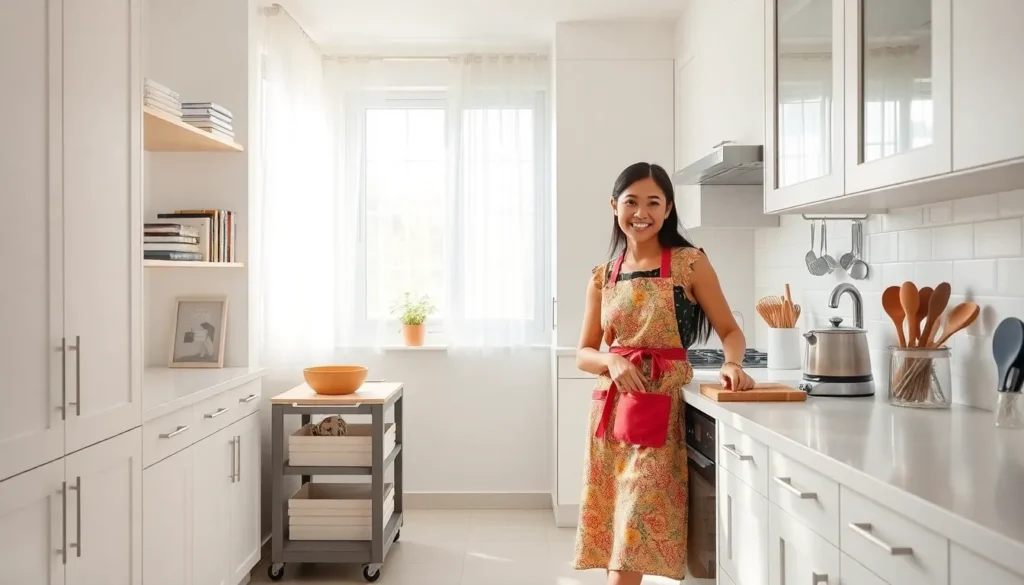We’ve all walked into a galley kitchen and felt that familiar squeeze – those long narrow spaces that make cooking feel like handling a ship’s corridor. But here’s what we’ve discovered after years of designing these compact powerhouses: galley kitchens aren’t limitations, they’re opportunities.
These streamlined spaces actually offer incredible efficiency that larger kitchens can’t match. Everything you need sits within arm’s reach, creating the perfect culinary triangle that professional chefs dream about. We’ve seen homeowners transform cramped galley kitchens into stunning, functional spaces that rival any sprawling kitchen island setup.
Whether you’re dealing with a tiny apartment galley or a narrow kitchen in your family home, we’ll show you how to maximize every inch. From clever storage answers that’ll make you forget about your space constraints to design tricks that create the illusion of width, these galley kitchen ideas will completely change how you think about your cooking space.
Maximize Storage with Vertical Solutions
Vertical space transforms your galley kitchen from cramped to capacity rich. We’ll show you how to use every inch from floor to ceiling for maximum storage efficiency.
Install Floor-to-Ceiling Cabinets
Floor-to-ceiling cabinets create an impressive 40% more storage space compared to standard height installations. We recommend extending your upper cabinets all the way to the ceiling to eliminate that dust-collecting gap above traditional cabinets.
Upper cabinet extensions work perfectly for storing seasonal items like holiday dishes, large serving platters, and small appliances you don’t use daily. Consider installing pull-down shelving systems in the highest cabinets to access items safely without climbing on counters or chairs.
Pantry towers fit beautifully at the end of galley runs, providing dedicated space for dry goods, cleaning supplies, and bulk items. These tall units typically measure 84 to 96 inches in height and can store up to 60% more items than traditional base cabinets.
Add Open Shelving Above Counter Height
Open shelving above your counters creates visual breathing room while adding functional storage space. We suggest installing floating shelves 18 to 20 inches above your countertop to maintain comfortable workspace clearance.
Display storage works wonderfully for everyday dishes, glassware, and attractive containers that enhance your kitchen’s aesthetic. Glass jars filled with pasta, coffee beans, or spices become both storage answers and decorative elements.
Cookbook collections find perfect homes on open shelves, keeping your favorite recipes within easy reach while cooking. Position frequently used cookbooks at eye level and reserve higher shelves for reference books or decorative items.
Use Wall-Mounted Magnetic Strips and Hooks
Wall-mounted storage answers keep your counters clear while putting tools exactly where you need them. We recommend installing magnetic knife strips on the wall beside your prep area for safe, accessible knife storage.
Magnetic spice containers attach directly to your refrigerator side or a metal backsplash, freeing up valuable cabinet space. These containers typically hold 2 to 4 ounces of spices and create an organized, visible spice system.
Hook systems accommodate everything from measuring cups and cooking utensils to dish towels and oven mitts. Install rails with removable hooks under upper cabinets or on empty wall sections to customize your storage based on changing needs.
Create the Illusion of Space with Light Colors

Light colors work like magic in galley kitchens by reflecting natural and artificial light throughout the narrow space. We’ll show you how strategic color choices can transform your compact kitchen into an airy, welcoming environment.
Choose White or Light-Colored Cabinets
White cabinets reflect light more effectively than any other color choice, making your galley kitchen feel significantly larger. Light-colored cabinet finishes like cream, soft gray, or pale blue create the same spacious effect while adding subtle personality to your design.
Cabinet hardware in brushed nickel or polished chrome enhances the light-reflecting properties of white cabinetry. Glass-front cabinet doors on upper units allow light to pass through while maintaining storage functionality.
Glossy or semi-gloss cabinet finishes amplify the light-bouncing effect compared to matte surfaces. We recommend pairing white lower cabinets with slightly darker upper cabinets to create visual interest without compromising the open feel.
Paint Walls in Soft, Neutral Tones
Soft neutral wall colors like beige, cream, or pale gray create a seamless backdrop that visually expands your galley kitchen. These gentle hues provide warmth without overwhelming the narrow space or competing with your cabinet colors.
Cool-toned neutrals such as soft whites with blue undertones can make ceilings appear higher in galley layouts. Warm neutrals like mushroom or greige add coziness while maintaining the spacious illusion.
Painting the ceiling the same light color as your walls eliminates visual breaks that can make spaces feel choppy. We suggest using eggshell or satin paint finishes that reflect light without showing every fingerprint or scuff mark.
Select Light-Colored Countertops and Backsplashes
Light-colored countertops in white granite, pale quartz, or marble create continuous visual flow that extends the perceived width of your galley kitchen. These materials reflect both natural window light and under-cabinet lighting to brighten work surfaces.
White subway tile backsplashes installed in horizontal patterns can make galley kitchens appear wider than vertical installations. Light-colored glass tile backsplashes add subtle texture while maintaining the bright, airy atmosphere.
Matching your countertop and backsplash colors creates an unbroken visual plane that tricks the eye into seeing more space. We recommend selecting materials with subtle veining or patterns rather than bold designs that can make narrow spaces feel busy or cluttered.
Enhance Natural Light and Add Artificial Lighting
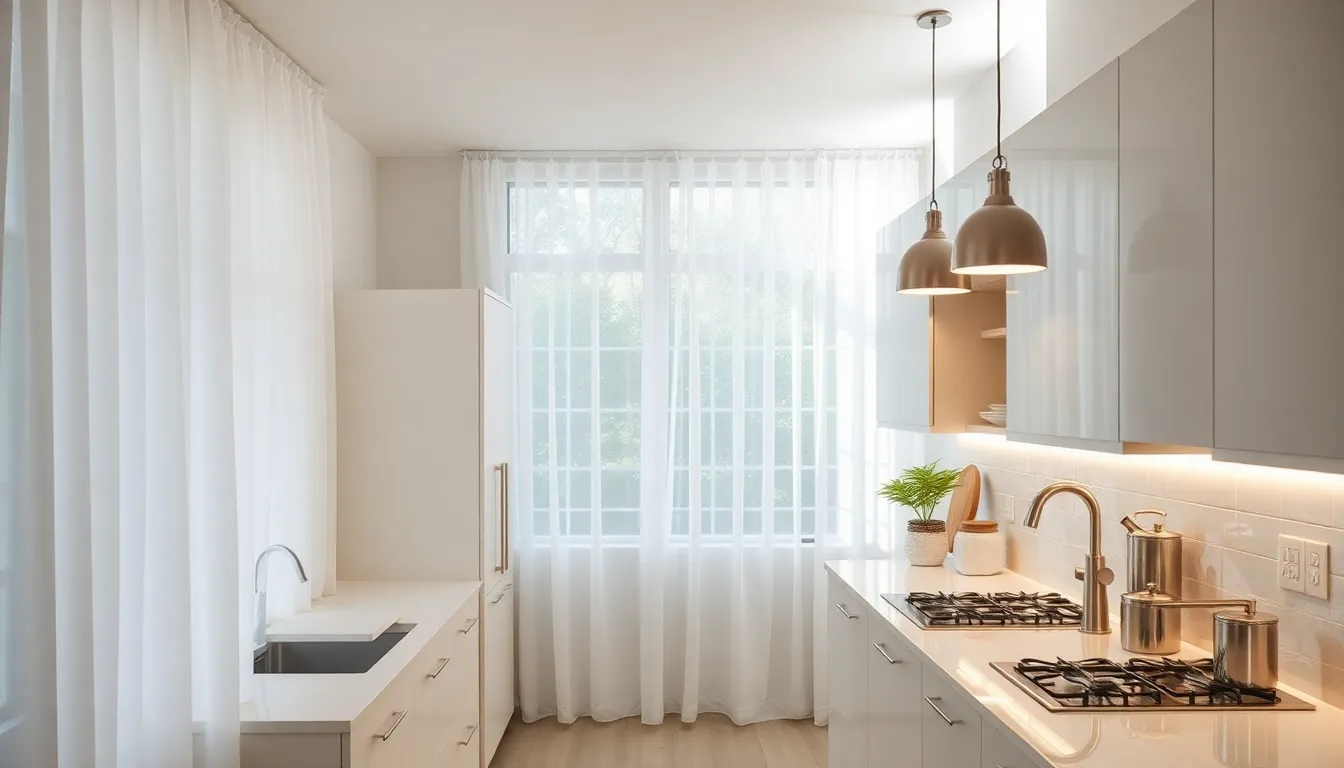
Natural light opens up galley kitchens instantly, while strategic artificial lighting creates warmth and functionality. We’ll show you how to maximize both lighting types to transform your narrow space.
Remove Heavy Window Treatments
Heavy curtains and bulky blinds block precious natural light from entering your galley kitchen. We recommend clearing or minimizing window treatments to let maximum sunlight flood the space, creating a brighter and more spacious feel.
Sheer curtains offer privacy while still allowing light to filter through. Roman shades provide a clean look when raised completely during daytime hours. Window films deliver privacy without sacrificing natural light, making them perfect for galley kitchens facing neighboring properties.
Install Under-Cabinet LED Lighting
Under-cabinet LED lighting eliminates shadows on countertops while adding valuable task lighting for food preparation. We suggest installing LED strips under wall cabinets to illuminate work surfaces and reduce the dark spaces that make galley kitchens feel cramped.
LED strips consume minimal energy while providing bright, even illumination across your entire counter span. Motion-activated LED lights offer hands-free convenience when your hands are full of ingredients. Warm white LEDs create a cozy atmosphere, while cool white options provide crisp task lighting for detailed cooking tasks.
Add Pendant Lights Over Work Areas
Pendant lights provide focused illumination over sinks and cooking stations without obstructing sightlines through your galley kitchen. We recommend installing pendant lights at key work zones to create visual interest while maintaining the open feel of your narrow space.
Drum pendants offer clean, modern aesthetics that complement contemporary galley designs. Industrial-style pendants add character without overwhelming the limited visual space. Mini pendants work perfectly in galley kitchens where ceiling height is limited, providing style and function in compact fixtures.
Optimize Counter Space with Smart Design Choices
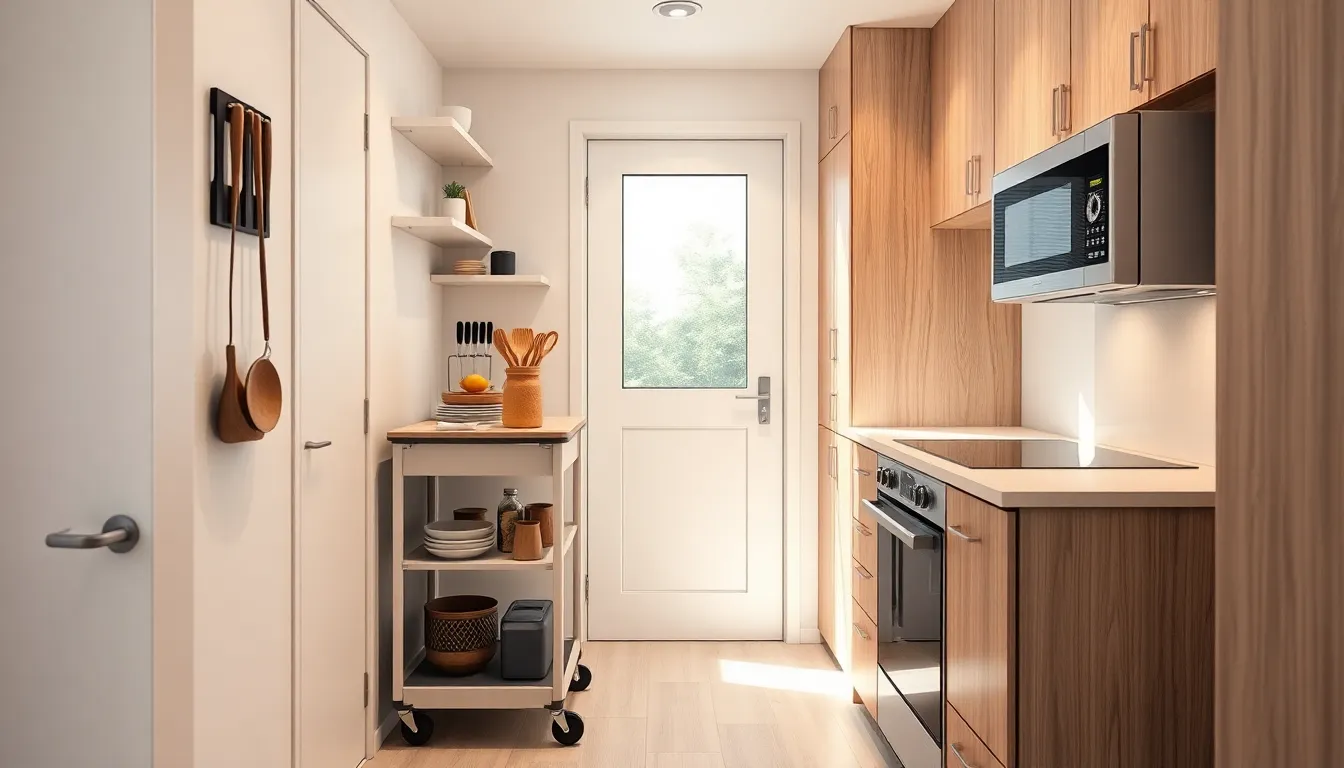
Counter space in galley kitchens requires strategic answers to maximize functionality while maintaining an open feel.
Install a Rolling Kitchen Cart
Rolling kitchen carts provide versatility and mobility that transforms how we use limited galley space. These portable workstations offer additional counter space exactly when we need it and can be easily moved out of the way to free up valuable floor space.
Storage becomes effortless with these carts since they serve as extra storage for utensils, pots, and other kitchen essentials. We can position them strategically during meal prep and roll them aside when entertaining guests or simply moving through the kitchen corridor.
Use Fold-Down Counter Extensions
Fold-down counter extensions deliver extra counter space without permanently altering our galley layout. These space-saving answers are ideal for food preparation or as temporary workspaces when we need additional room for cooking projects.
Space gets maximized efficiently since these extensions fold up against the wall when not in use, maintaining a clutter-free environment. We can install them at various heights to accommodate different tasks while preserving the kitchen’s streamlined appearance.
Choose Compact, Multi-Functional Appliances
Compact appliances help maximize available space in galley kitchens while maintaining full functionality. Examples include microwave toaster oven combos, compact refrigerators, and combination washer-dryer units that serve multiple purposes in one streamlined design.
Efficiency improves dramatically when we select appliances that reduce clutter and make the kitchen feel more spacious. These multi-functional units eliminate the need for separate appliances, creating more room for essential counter space and storage throughout our galley kitchen layout.
Incorporate Mirrors and Reflective Surfaces
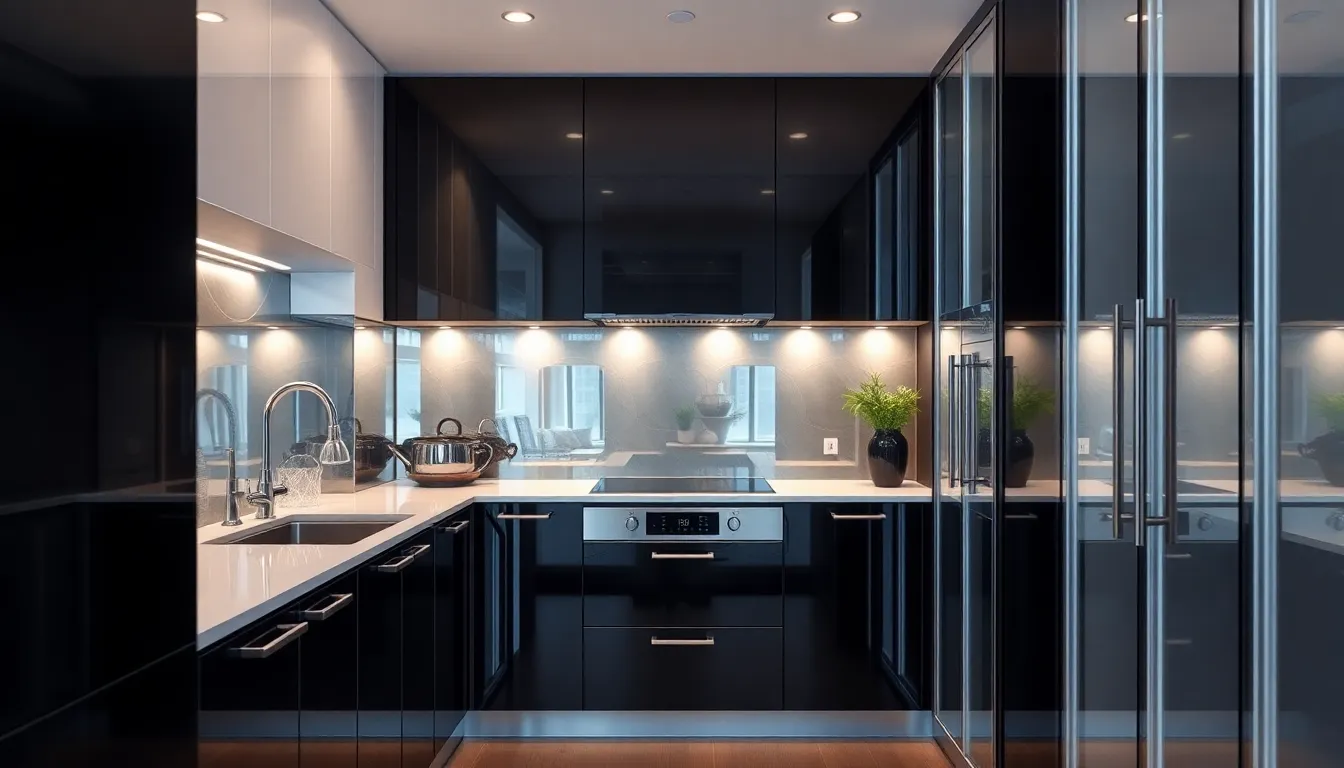
Reflective elements serve as our most powerful tools for transforming narrow galley kitchens into bright, airy spaces. These strategic additions bounce light throughout the room and create visual depth that counteracts the confined feeling typical of galley layouts.
Add a Mirrored Backsplash
Installing a mirrored backsplash creates the illusion of a wider, more spacious kitchen by doubling the visual width of your workspace. This proven technique bounces light around the room, making the area feel less confined and significantly more open than traditional tile or stone backsplashes.
Mirrored surfaces reflect both natural and artificial light sources, amplifying the brightness throughout your galley kitchen. Professional installation ensures proper mounting and easy maintenance, while the reflective quality adds a sophisticated, modern touch to your design scheme.
Consider antique mirror tiles for vintage charm or sleek mirror panels for contemporary appeal. The continuous reflection eliminates visual breaks that can make narrow spaces feel choppy, instead creating a seamless flow that extends your kitchen’s apparent boundaries.
Choose Glossy Cabinet Finishes
Selecting cabinets with glossy finishes increases light reflection and delivers a bright, modern appearance that opens up your galley space. These high-sheen surfaces bounce light between parallel walls, creating visual movement that prevents the kitchen from feeling static or cramped.
Glossy finishes come in various colors to match different design preferences, from classic white lacquer to bold navy blue or sophisticated charcoal. The reflective quality works particularly well in galley kitchens because it maximizes the impact of both overhead lighting and natural light from windows.
Professional-grade glossy finishes resist fingerprints and clean easily with simple soap and water. This practical benefit makes them ideal for high-traffic galley kitchens where functionality matters as much as aesthetics.
Install Glass Cabinet Doors
Replacing solid cabinet doors with glass-fronted alternatives enhances the sense of openness by allowing visibility into storage areas. Glass doors reflect light while creating visual depth, making your galley kitchen appear less cramped and more spacious than traditional closed cabinetry.
Frosted glass options provide privacy for less organized shelves while still reflecting light and maintaining an open feel. Clear glass works best when you want to showcase beautiful dishes or glassware, turning functional storage into decorative display space.
Glass cabinet doors offer both aesthetic and practical benefits by reflecting light sources and creating the illusion of extended space. The transparency breaks up the visual weight of upper cabinets, preventing them from feeling heavy or overwhelming in your narrow galley layout.
Design an Efficient Work Triangle
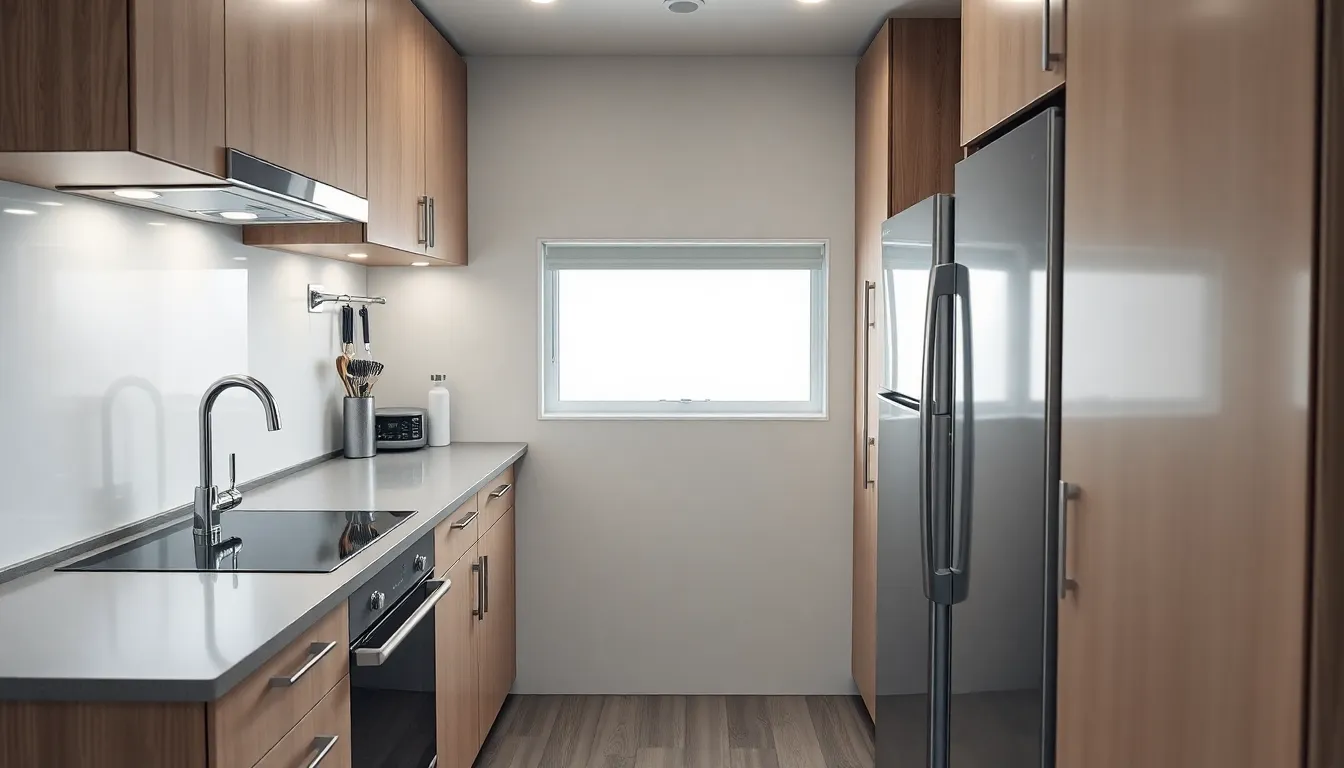
Creating an effective work triangle forms the foundation of every successful galley kitchen design. We’ll show you how to position your major appliances and maintain clear workflow pathways for maximum efficiency.
Position Sink, Stove, and Refrigerator Strategically
Place your sink, stove, and refrigerator on the two opposing counters to create a triangular arrangement. This strategic positioning allows for smooth movement between cooking zones while maintaining the compact efficiency that makes galley kitchens so practical. We recommend keeping each side of the triangle between four and nine feet to ensure everything stays within easy reach without creating congestion.
Position the refrigerator at one end of your galley for optimal ingredient access. This placement allows you to grab items and move naturally toward the preparation and cooking areas. The sink works best in the middle section, providing a central washing and prep station that connects both ends of your kitchen workflow.
Install your stove or cooktop at the opposite end from the refrigerator to complete the triangle. This arrangement creates a logical sequence that streamlines your cooking process from ingredient retrieval to final preparation. The triangular layout minimizes the energy expenditure required for meal preparation while maximizing your galley kitchen’s natural efficiency.
Ensure Clear Pathways Between Work Areas
Maintain at least four feet of width in your central walkway to accommodate multiple users. This spacing allows family members to move freely through the kitchen without disrupting the cook’s workflow. In smaller galley spaces, we suggest aiming for a minimum of three feet of clear corridor space to maintain functionality.
Keep the area between your work triangle free of furniture and unnecessary appliances. Clear pathways prevent obstruction during meal preparation and reduce the risk of accidents in your compact cooking space. We’ve found that removing clutter from the central walkway dramatically improves both safety and efficiency.
Consider integrating a narrow island only if it doesn’t disrupt your established work triangle. Islands can provide additional storage and counter space, but they must maintain clear pathways and preserve the flow between your major appliances. Replace one set of cabinets with an island only when space truly allows for this enhancement.
Minimize Steps Between Key Functions
Arrange your appliances and prep spaces in a logical cooking sequence for maximum efficiency. Start with the refrigerator for ingredient access, move to the sink for washing and prep work, then finish at the stove for cooking. This natural progression reduces unnecessary movement and creates a streamlined workflow that makes cooking more enjoyable.
Group related items near their corresponding work zones to reduce travel time. Store pots and pans near the stove, cutting boards and knives close to the sink, and frequently used ingredients within easy reach of your prep areas. We recommend organizing your galley kitchen so that each cooking task can be completed with minimal steps between functions.
Use vertical storage answers to keep essential tools within arm’s reach of their work areas. Wall mounted magnetic strips near the stove keep cooking utensils accessible, while hooks near the sink hold dish towels and cleaning supplies. This strategic placement ensures that everything you need stays within the efficient boundaries of your work triangle.
Add Visual Interest with Strategic Design Elements
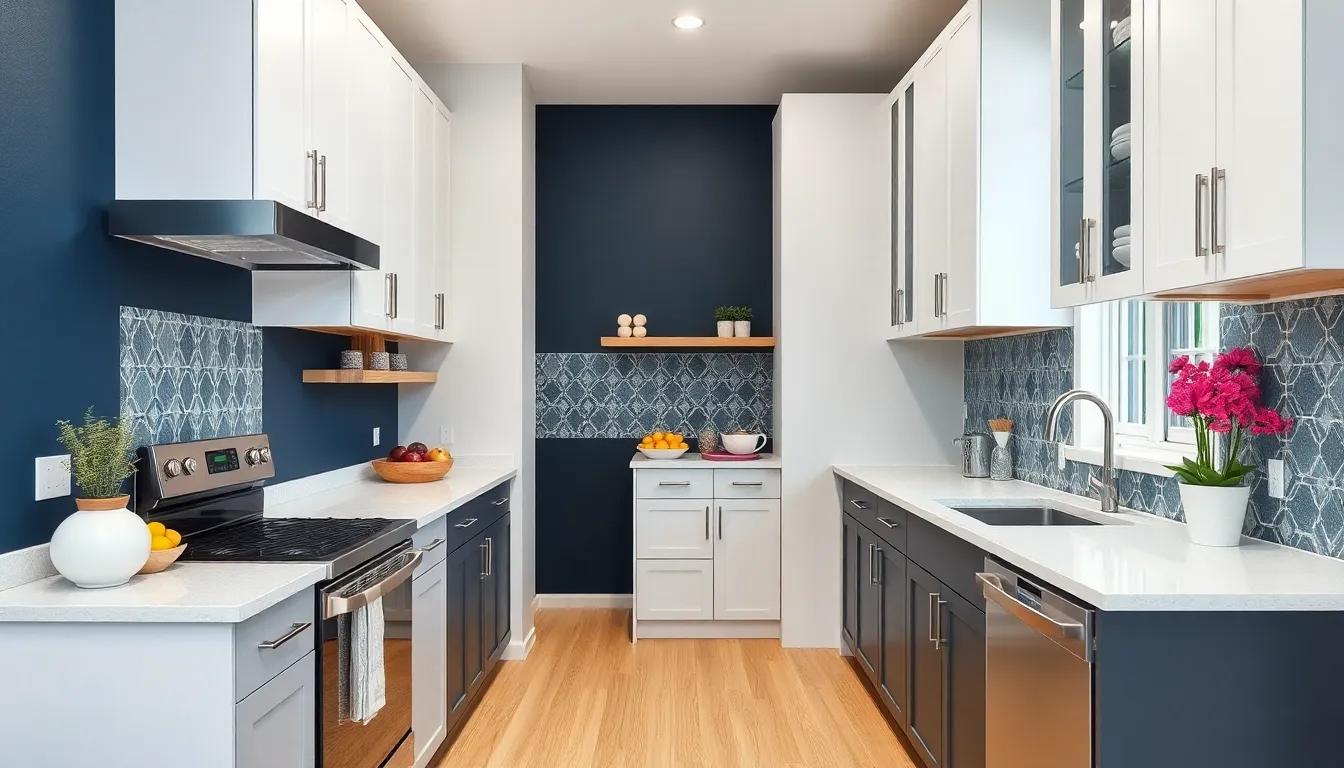
While galley kitchens excel at efficiency, they need thoughtful design elements to avoid feeling monotonous. We’ll show you how strategic visual enhancements can transform your narrow kitchen into an captivating, ever-changing space.
Create a Bold Accent Wall
Colorful accents on a single wall instantly break up the linear monotony that often plagues galley kitchen designs. We recommend choosing vibrant hues like deep navy, emerald green, or warm terracotta to create a stunning focal point that draws the eye and adds personality to your space.
Patterns work exceptionally well in galley kitchens when applied strategically to one wall surface. Consider geometric wallpaper designs, subway tile arrangements, or even textured paint techniques that add depth without overwhelming the narrow space. These elements create visual intrigue while maintaining the kitchen’s functional flow.
Install Decorative Tile Backsplashes
Glass tile backsplashes serve dual purposes in galley kitchens by adding elegance and reflecting light throughout the space. We’ve seen these installations make kitchens feel significantly larger while providing easy maintenance and timeless appeal that enhances property value.
Geometric patterned tiles create modern, ever-changing looks that perfectly complement contemporary galley kitchen designs. Hexagonal shapes, chevron patterns, or subway tiles arranged in herringbone formations add sophisticated visual movement without cluttering the streamlined aesthetic your galley kitchen requires.
Use Contrasting Colors for Upper and Lower Cabinets
Contrasting colors between upper and lower cabinets create instant visual depth that tricks the eye into perceiving more space. We suggest pairing lighter upper cabinets with darker lower ones, such as crisp white uppers with charcoal gray or navy blue base cabinets, to achieve this striking effect.
Neutral backgrounds like white or light gray walls allow contrasting cabinets to become the star attraction in your galley kitchen design. This approach prevents overwhelming the space while ensuring your carefully chosen cabinet colors remain the focal point that defines your kitchen’s character and style.
Maximize Floor Space with Wall-Mounted Features
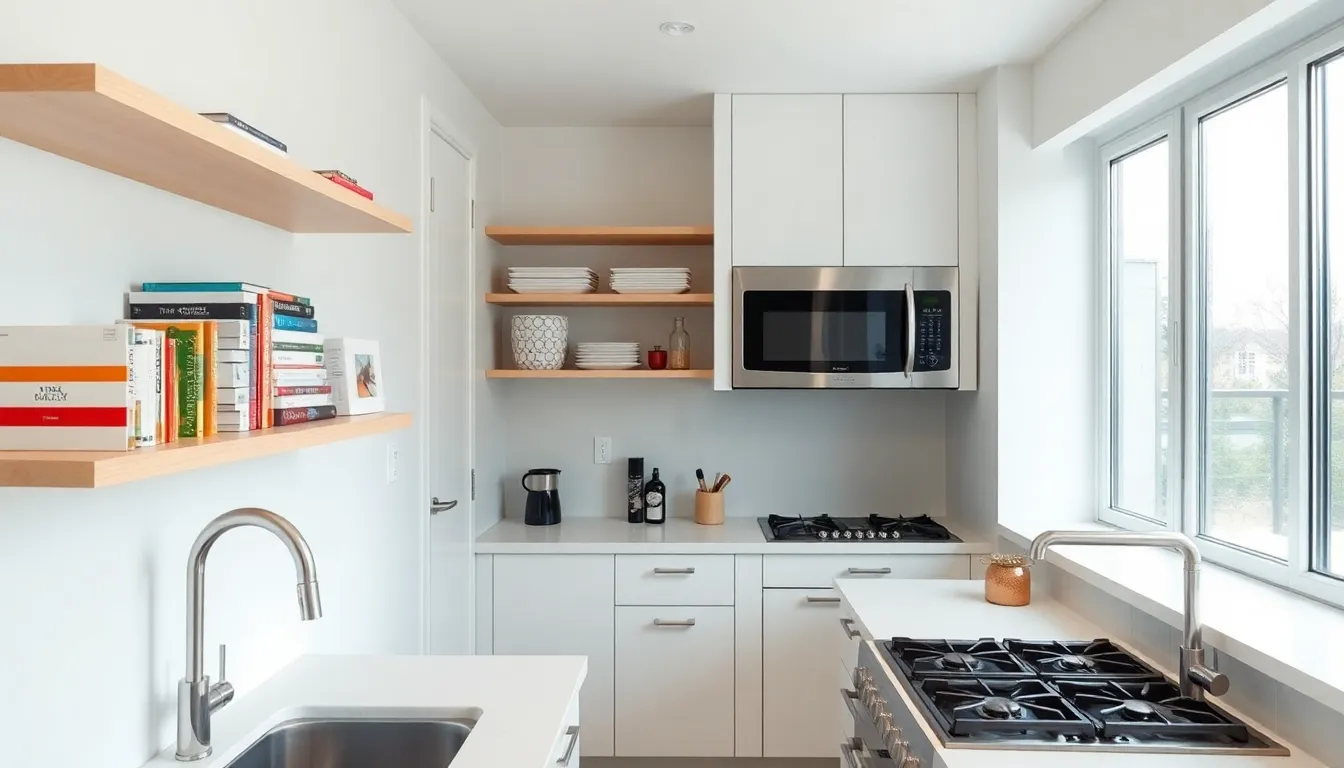
Wall-mounted features transform galley kitchens by lifting functional elements off the floor and creating a sense of openness. This approach allows us to maintain essential storage and functionality while visually expanding our space.
Install Wall-Mounted Faucets
Wall-mounted faucets offer a sleek solution for galley kitchens where counter space comes at a premium. These fixtures eliminate the need for deck-mounted hardware, freeing up valuable sink area for food preparation and dish storage. Installation requires careful planning since plumbing lines run through the wall rather than beneath the counter.
Modern wall-mounted faucets come in various finishes that complement our chosen hardware throughout the kitchen. Brushed nickel and polished chrome options work particularly well with the light-reflecting surfaces we’ve discussed. The clean lines of these fixtures enhance the streamlined aesthetic that makes galley kitchens feel more spacious.
Choose Floating Vanities and Shelves
Floating shelves create dramatic visual impact while providing essential storage in our galley kitchen design. These wall-mounted elements maintain the clean lines we need while offering space for cookbooks, spices, and decorative items that personalize our cooking space.
Strategic placement of floating shelves maximizes their effectiveness without overwhelming the narrow layout. We can install them above counter height to maintain clear sightlines while keeping frequently used items within easy reach. Glass or light-colored wood shelves work best since they won’t visually weigh down the space.
Multiple floating shelves arranged in staggered patterns add visual interest while breaking up the linear monotony of traditional galley layouts. This approach allows us to display both functional and decorative elements that reflect our personal style.
Mount Appliances When Possible
Over-the-range microwaves represent one of the most effective space-saving answers for galley kitchens. Installing these appliances frees up valuable counter space while providing both cooking functionality and ventilation for our stovetop below.
Wall-mounted smaller appliances like toasters, blenders, or coffee makers can be secured to brackets or shelves that swing out when needed. This approach keeps our counters clear for food preparation while maintaining easy access to frequently used items.
Under-cabinet mounting systems work particularly well for items we use daily but don’t want cluttering our limited counter space. Hooks and rods installed beneath wall cabinets provide storage for mugs, tea towels, and oven mitts without occupying any cabinet interior space.
Create Seamless Flow with Consistent Flooring

We’ve explored various strategies to optimize galley kitchens, and now we’ll focus on how flooring choices can dramatically transform these spaces by creating visual continuity and flow.
Extend Kitchen Flooring into Adjacent Areas
Extending the same flooring material from your galley kitchen into neighboring rooms creates a powerful visual expansion effect. This design strategy eliminates abrupt transitions that can make your kitchen feel choppy and confined. We recommend carrying your kitchen flooring into dining areas, hallways, or living spaces to establish an uninterrupted flow that makes the entire area appear larger and more unified.
Seamless flooring transitions trick the eye into perceiving one continuous space rather than separate compartments. When you maintain consistent materials throughout connected areas, you eliminate visual barriers that would otherwise segment your home’s layout. This approach proves particularly effective in open-concept designs where your galley kitchen flows into other living spaces.
Choose Light-Colored, Wide-Plank Flooring
Light-colored flooring serves as a foundation for creating an airy, spacious feeling in your galley kitchen. Wide-plank options enhance this effect by reducing the number of visible seams across your floor surface, which helps eliminate visual clutter that can make narrow spaces feel even more cramped. We suggest considering materials like light oak, maple, or whitewashed hardwood to maximize light reflection throughout your kitchen.
Wide planks create fewer interruptions in your sight lines, allowing your eyes to travel smoothly across the entire floor surface. This continuity contributes to the illusion of expanded space by providing a clean, unbroken foundation for your kitchen design. Light tones also reflect both natural and artificial light more effectively, bouncing illumination throughout your galley kitchen to combat the shadowy corners that often plague narrow layouts.
Avoid Busy Patterns That Break Up Space
Busy flooring patterns create visual fragmentation that can make your galley kitchen feel smaller and more chaotic. We recommend steering clear of checkerboard designs, complex geometric patterns, or high-contrast tiles that draw attention to the floor rather than creating a neutral backdrop. These intricate designs force the eye to focus downward and process multiple visual elements, which can overwhelm the already compact space.
Simple, uniform flooring allows your kitchen’s other design elements to take center stage while providing a calming foundation. Contrasting transitions between rooms also disrupt the seamless flow we’re trying to achieve, so maintaining consistency across spaces becomes crucial for maximizing your galley kitchen’s perceived size and creating that coveted open, unobstructed atmosphere.
Conclusion
Transforming your galley kitchen doesn’t require a complete overhaul—it’s about making smart design choices that work with your space rather than against it. We’ve shown you how strategic lighting placement thoughtful storage answers and clever visual tricks can turn even the narrowest kitchen into a functional and beautiful space.
Remember that success lies in the details. From choosing the right flooring to creating an efficient work triangle every element should serve a purpose while contributing to the overall sense of openness and flow.
Your galley kitchen has more potential than you might think. With these proven strategies you’ll create a space that not only meets your daily needs but becomes a kitchen you’re truly proud to call your own.
Frequently Asked Questions
What are the main advantages of galley kitchens?
Galley kitchens offer exceptional efficiency by keeping everything within easy reach, creating an optimal work triangle between sink, stove, and refrigerator. Despite their narrow layout, they maximize functionality through strategic design and can be transformed into stunning spaces that rival larger kitchens through clever storage solutions and space-enhancing design tricks.
How can I maximize storage in my galley kitchen?
Utilize vertical space by installing floor-to-ceiling cabinets, which provide up to 40% more storage than standard cabinets. Add pantry towers for bulk storage, use open shelving above counter height, and install wall-mounted magnetic strips and hooks. Upper cabinet extensions work perfectly for storing seasonal items you don’t need daily.
What colors work best to make galley kitchens feel larger?
Choose white or light-colored cabinets that reflect light and create an open feel. Use soft, neutral wall colors, light-colored countertops, and matching backsplashes to create visual flow. Glossy finishes, glass-front cabinet doors, and brushed nickel or polished chrome hardware enhance the light-reflecting effect and make spaces appear wider.
How can I improve lighting in my galley kitchen?
Maximize natural light by removing heavy window treatments and using sheer curtains or Roman shades instead. Install under-cabinet LED lighting to eliminate shadows and provide task lighting. Add pendant lights over work areas for visual interest while maintaining an open feel, and consider various contemporary styles that complement compact spaces.
What are the best ways to optimize counter space?
Install rolling kitchen carts for versatile, mobile counter space that can be stored away when not needed. Use fold-down counter extensions that tuck away to maintain a clutter-free environment. Choose compact, multi-functional appliances like microwave-toaster oven combos and consider wall-mounted appliances to keep counters clear and maximize functionality.
How can mirrors and reflective surfaces help my galley kitchen?
Install a mirrored backsplash to create the illusion of width and brightness. Choose glossy cabinet finishes to enhance light reflection and modernize the space. Replace solid cabinet doors with glass-fronted alternatives to increase openness and visual depth, making your narrow kitchen feel more spacious and airy.
What flooring choices work best for galley kitchens?
Extend the same flooring material from your kitchen into adjacent areas to eliminate transitions and enhance space perception. Choose light-colored, wide-plank flooring to maximize light reflection and reduce visual clutter. Avoid busy patterns that fragment the space, and maintain consistent flooring throughout connected areas for a unified, spacious feel.
How do I create an efficient work triangle in a galley kitchen?
Position your sink, stove, and refrigerator strategically to minimize steps between functions. Maintain clear pathways with adequate width between work areas for safety and efficiency. Group related items near their corresponding work zones and utilize vertical storage to keep essential tools within easy reach, streamlining your cooking process.

